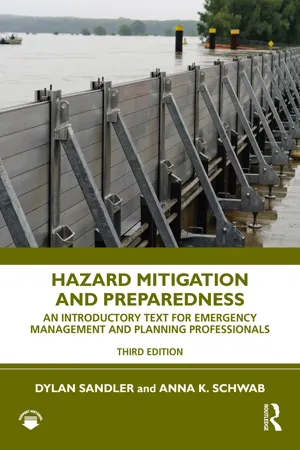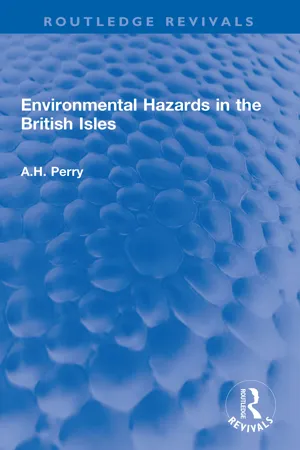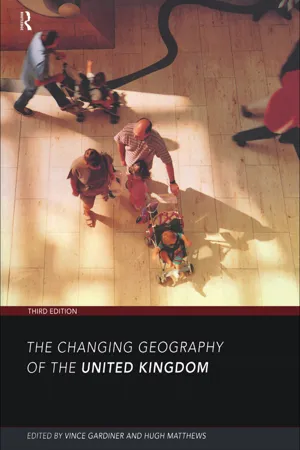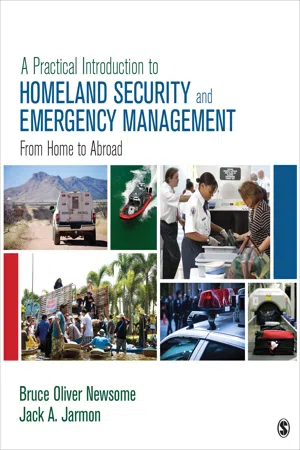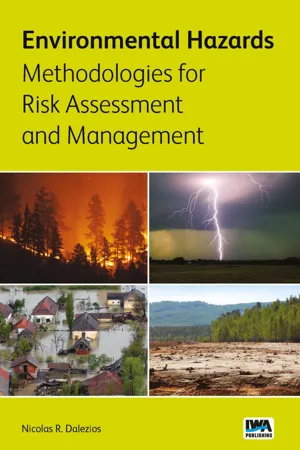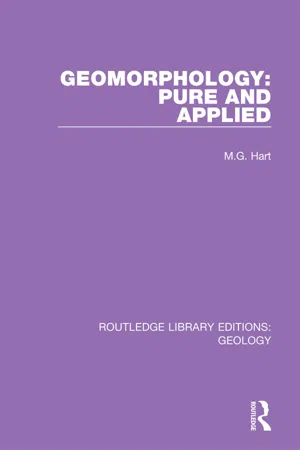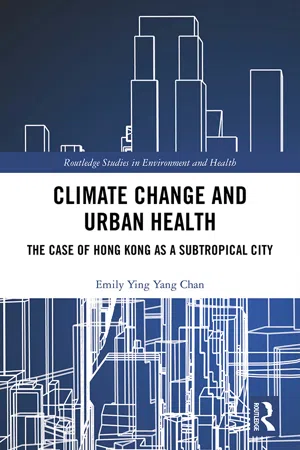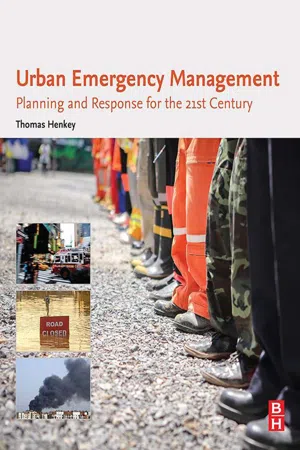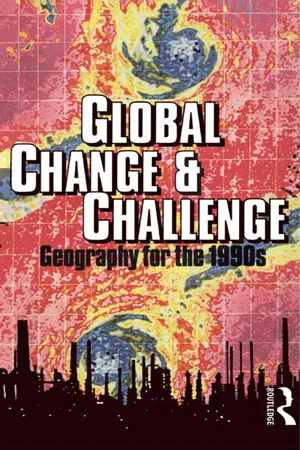Geography
Weather Hazards in the UK
The UK experiences a range of weather hazards, including storms, heavy rainfall, and flooding. Storms, such as those caused by low-pressure systems, can bring strong winds and heavy rain, leading to potential damage and disruption. The country's geography and proximity to the Atlantic Ocean make it particularly susceptible to these weather hazards.
Written by Perlego with AI-assistance
Related key terms
Related key terms
1 of 4
Related key terms
1 of 3
11 Key excerpts on "Weather Hazards in the UK"
- eBook - ePub
Hazard Mitigation and Preparedness
An Introductory Text for Emergency Management and Planning Professionals
- Dylan Sandler, Anna K. Schwab(Authors)
- 2021(Publication Date)
- Routledge(Publisher)
hydrological, which result from the Earth's water systems. This chapter focuses on the following major meteorological and hydrological hazards: hurricanes, sea level rise, floods, drought, wildfire, tornadoes, severe winter weather, and extreme heat. Although wildfire is not necessarily caused by weather patterns, it is included in this chapter because certain weather conditions must be present for wildfire to occur. We discuss some of the main characteristics of these natural hazards, what to expect during the course of a hazard event, how the hazards are ranked in terms of severity, and some of the impacts they can have on our communities.3.1 WEATHER-RELATED NATURAL HAZARDS
Between the years 1980 and 2019, there were 273 weather and climate disasters in the United States that reached over $1 billion each in damages.1 In 2005, a single weather-related event by the name of Hurricane Katrina exceeded all of the previous disasters in this category in terms of property damage, resulting in a total estimated cost of $170 billion, and resulted in 1,833 deaths. In 2017, an extremely active hurricane season, multiple major storms struck the U.S. Hurricane Maria devastated Puerto Rico with a death toll near 3,000. Other parts of the country have experienced their share of weather phenomena – including massive flood events and devastating tornadoes in the Midwest, blizzards and ice storms in the north, and highly destructive wildfires in the western states.These and other weather-related hazards fall into two major categories:- Meteorological hazards: A weather event that occurs because of processes in the Earth's atmosphere.
- Hydrological hazards: A weather event that occurs as part of the Earth's water systems.
- eBook - ePub
- A.H. Perry(Author)
- 2023(Publication Date)
- Routledge(Publisher)
The variability and complexity in natural and human systems can make some phenomena, for example a river, both a hazard and a resource. Hazards have been defined by Gardiner (1977) as ‘events, objects, processes and substances that are perceived to cause more damage to, or impose more costs on, society than the benefits they give’. Research has particularly focused on natural hazards defined by Burton and Kates (1964) as ‘those elements of the physical environment harmful to Man and caused by forces extraneous to him’, and for the purpose of a symposium in Australia in 1976 as ‘those extreme geophysical events greatly exceeding normal human expectation in terms of their magnitude or frequency and causing major human hardship with significant material damage to Man and his works and possible loss of life’. As such, they occur as an interaction between systems of human resource management and systems of geophysical events. By definition then, a hazard is a function both of the physical event itself and of the state of human society, including specifically the adjustment adopted to cope with the hazard and the state of preparedness. Hazard events become hazardous only when harmful interactions occur with populations, activities and wealth, and with the environments that humans value and need. The extreme geophysical events collectively referred to as natural hazards stand near one end of a spectrum of phenomena ranging from natural to humanly-induced hazards (Fig. 1.1). Natural hazards can be viewed as processes whereby energy is transferred rapidly from the environment to the works of Man, inflicting damage to both life and property. It is not the total amounts of energy released that create natural disasters but energy concentrated and delivered over short-time intervals. In the British Isles it is the rapid movement of air and water or land and the interconnection between these elements when the movement takes place that is responsible for hazardous events - eBook - ePub
Environmental Hazards
Assessing Risk and Reducing Disaster
- Keith Smith(Author)
- 2013(Publication Date)
- Routledge(Publisher)
Hazards and disasters can no longer be viewed as one-off, site-specific events capable of regulation by local responses alone. In some instances the wider links and consequences are fairly clear; for example, global warming drives sea-level rise, which leads to increased risks from coastal floods. Other questions, such as the adverse effects of natural hazards on economic development, or on the future security of food and water supplies, are less self-evident. Unlike traditional ‘natural hazards’, many of these complex interrelationships have become prominent recently and thereExtreme geophysical events and severe system failures within a framework of global change and sustainability issues.Figure 1.2is a lack of historical experience and scientific record to enable understanding. As a result, some key issues — like the impact of climate change on environmental hazards — remain controversial within both scientific and political circles (see Chapter 14 ).Most environmental hazards can be placed on an approximate scale of causation, ranging from entirely natural forces to examples subject to considerable human influence (Figure 1.3 ) As the scale moves from rarer, uncontrolledA generalized spectrum of environmental hazards from physical to human causes. Risks with a high level of human causation are more readily accepted and more diffuse in terms of disaster impact.Figure 1.3natural events (asteroid impact, earthquake) through more ‘quasi-natural’ hazards (landslide, bushfire) towards more common technological-type hazards (transport accident, air pollution), so disaster impacts tend to become less concentrated within a particular community. As the extent of human causation grows, the risk spreads and the public tends to be more accepting of any loss. Entirely voluntary life-style hazards, such as cigarette smoking or mountaineering, are excluded from this book because they are wholly man-made, self-inflicted risks. Similarly, hazards of mass violence are excluded because crime, warfare and terrorism are intentional harmful acts on humans by humans. On the other hand, some societal characteristics do influence hazard impacts, either directly or indirectly. For example, certain epidemics of infectious disease are accepted in this book because they are not only a major cause of disaster deaths but are also related to environmental conditions. Factors such as poverty, ill-health and environmental degradation are not hazards in themselves but they have indirect effects by amplifying human vulnerability to hazardous events (see Chapter 3 - eBook - ePub
- Hugh Matthews, Vince Gardiner(Authors)
- 2002(Publication Date)
- Routledge(Publisher)
Hazard is an attribute that is definable as the propensity to cause harm, loss or adverse consequences. It is a human construct attributable to objects, substances, activities, processes or circumstances that result in harms, losses or costs to humans and what they value. Hazards are, therefore, defined by humans and not nature. They are cultural constructions and as human societies evolve and knowledge increases so too do the criteria for determining hazard and the range of phenomena that receive the label. As a consequence, hazard must be envisaged as a dynamic concept, in many regards similar to the concept of resource: indeed, Zimmerman’s famous statement about resources can be adapted to hazard to yield ‘hazards are not, they become’.Traditionally, three broad groups of hazard have been recognised, ‘social’, ‘technological’ and ‘natural’, with much of the geographical literature focusing on the so-called ‘natural hazards’ which can be defined as ‘those naturally occurring elements of the physical environment harmful to humans, human activity and the things that humans value’. Two broad categories are normally distinguished, geophysical and biological, which are capable of considerable further subdivision (e.g. atmospheric, geomorphological, floral, faunal, etc.). Attention on ‘natural hazards’ has been reinforced during the 1990s due to the United Nations proclaimed International Decade for Natural Disaster Reduction (IDNDR), which has sought to reduce the costs to global society arising from geophysical events (the so-called ‘natural tax’) by the international pooling of knowledge and expertise on how to mitigate adverse impacts.However, the validity of the fundamental threefold division of hazards has also come to be questioned as research has shown that many hazard events are surprisingly complex in the sense that they involve combinations of ‘social’, ‘technological’ and ‘natural’ elements. The basic ‘four phase’ model of hazard—Incubation-Trigger-Primary Hazard-Consequences— reveals that while the trigger event and primary hazard may be easily categorised into one of the three main groups (although not necessarily the same group), the incubation process and the resulting consequences (impacts, further hazards, benefits) often involve complex combinations. This is well illustrated by the nuclear fall-out from the Chernobyl nuclear accident (28 April 1986) which was the result of technological failure due to poor operating practices (social), with the adverse impacts on the sheep-rearing industry in Britain arising because the radioactive material had been transported by the wind and deposited by rain so as to produce a spatially variable pattern of contamination (Figure 17.1 - eBook - ePub
The Natural and the Social
Uncertainty, Risk, Change
- STEVE HINCHLIFFE, Kathryn (Kath) Alison Woodward(Authors)
- 2015(Publication Date)
- Routledge(Publisher)
In sum, the aim of this chapter is to investigate environmental risk by highlighting the ways in which the two poles of nature and society become entangled as we look more closely at threats and hazards. In addition, the argument will be made that part of our current predicament with regard to environmental risks is that we tend to view the world as made up of bits of society and bits of nature. Once we start to collapse these distinctions we may be in a better position to live more effectively with risk.2 The Unnatural Geography of Natural Hazards
The one thing that you can always rely on in Britain is the unreliability of the weather. In 1998, the British climate seemed to have been unusually unreliable. And the damage was immense (particularly for the people who lived in areas of storm damage or flooding). At the start of the year, ‘freak’ windstorms tore offroofs in Selsey Bill. At the end of the year, storm-driven waves battered the coastline to such an extent that parts of Beachy Head, near Eastbourne, crumbled into the sea. The weather-beaten British Isles seemed to be caving in, physically, and in the case of the white, chalk cliffs of south-east England, symbolically. Easter, 1998, saw large parts of England and Wales under water. Five people died as a result of the floods. Over 4,000 properties were flooded. In autumn, the floods returned. People started to look for someone or something to blame. People wanted to know the cause of all this damage and disruption to the established order. In the distant past, accidents were blamed on the gods, a God or some other supernatural entity. Today we tend to look for new scapegoats or ‘non-caused causes’ (see Box 4.1 ). In Section 2.1, we shall look at who or what gets the blame for such events. Sections 2.2 and 2.3 then discuss who or what benefits from the ways in which we explain such hazards and risks.FIGURE 4.1 A weather-beaten coastal town – Tynemouth, north-east EnglandBox 4.1 ActsofGodtoactsofElNin˜o–acausewithout a cause, a new scapegoat?El Niño is a name used to describe the warm oceanic and atmospheric conditions that can occur along the western coast of Ecuador and Peru. The term initially referred to the annual shift in ocean currents that brings warm weather around the end of December (El Niño means ‘baby’ in Spanish and refers to the events surrounding the nativity in the Christian calendar). El Niño now more generally refers to an unusually intense occurrence of this annual shift which brings even warmer atmospheric and oceanic conditions. These unusual events occur every three to seven years. - eBook - ePub
A Practical Introduction to Homeland Security and Emergency Management
From Home to Abroad
- Bruce Oliver Newsome, Jack A. Jarmon(Authors)
- 2015(Publication Date)
- CQ Press(Publisher)
- Profound political and social instability (World Economic Forum, 2014, p. 9)
Natural Hazards and Threats in General
This section defines natural hazards and threats, reviews trends in natural risks, and describes the distribution of natural hazards and threats.Defining Natural Hazards and Threats
Hazards are things in a nonharmful state; threats are in a harmful state. Natural risks are risks that arise from natural sources; these sources are natural in that they exist without human creation, although human activities are often necessary to activate hazards as threats. Where humans activate the threat from a natural hazard, many authorities would regard the threat as a human-made threat or a human-manufactured threat, even though their effects are often indistinguishable.Unfortunately, we have no standard list of natural risks. The International Risk Governance Council’s list of natural forces (wind, earthquakes, volcanic activities, drought, flood, tsunami, wildfire, avalanche) is incomplete (see Table 6.1 ).Similarly, the Canadian government’s taxonomy categorizes natural risks as meteorological, geological, and ecological, separate from health and “emerging phenomena and technologies,” which include many natural risks (see Table 6.2 ).Munich Reinsurance Group (2011) counts geophysical events (earthquakes, tsunami, volcanic eruptions, dry-earth movements), meteorological events (storms), hydrological events (floods, wet mass movements), and climatalogical events (extreme temperatures, droughts, and wildfires). Munich Re orders natural events from Class 0 to Class 6 (see Table 6.3 - Nicolas R. Dalezios(Author)
- 2017(Publication Date)
- IWA Publishing(Publisher)
In general, it is not easy to distinguish between atmospheric and non-atmospheric factors, which cause and produce climatic hazards (Maarouf & Munn, 2005). Indeed, increasing diachronic losses emphasize on the significance of socioeconomic factors resulting in vulnerability of communities to hazard events. It is mentioned that a broad distinction can be made between tropical cyclones affecting large areas and severe local storms, along with their associated weather extremes, which involve a sudden impact of very large energy amounts discharged over relatively short periods. On the other hand, specific hazard features result into cumulative hazards when they reach or exceed threshold magnitudes (Gentilli, 1979). Typical examples are heatwaves, cold spells, flood-producing rains, frosts, fogs, droughts, high winds, snow and ice associated with extratropical low-pressure systems, as well as climate change impacts. Furthermore, certain climatic hazards originate from human activity. Indeed, these hazards include biological hazards, impacts to human health, the possible risk of accidental modification of climatic patterns, as well as acid rain impacts on natural ecosystems.8.1.1 Climate hazardsPotential atmospheric hazards are considered thunderstorms, tornadoes, tropical and extra-tropical cyclones, lightning, hail, snow, drought, fog, temperature extremes, strong winds, air pollution, as well as climatic change and its impacts. Hazards may arise either from single-element extremes, such as excessively low temperatures causing physiological cold stress or from a combination of elements, such as tropical cyclones with strong wind, storm surge and torrential rain, which cause threats to properties and the population. Annual global economic losses attributed to meteorological disasters have indicated an increase from the 1960s to the early 1990s to almost $90 billion, whereas insured losses increased to over $50 billion (Bruce, 1994).Sudden-impact hazards . Tropical cyclones can be the most deadly and harmful storms on Earth. They are usually characterized by low predictability and fast movement. The major threats to properties and population are caused by three distinct hazards, namely torrential rain, storm waves and surges and gust winds. Severe local storm- eBook - ePub
- M.G. Hart(Author)
- 2020(Publication Date)
- Routledge(Publisher)
12 Environmental hazardsIntroduction
One of the situations that is of concern to the applied geomorphologist is that in which geomorphological events have a direct impact on man. To some extent man everywhere is influenced by geomorphology. Obviously, the geomorphologist is not involved in every conceivable situation, but he is, or can be, involved when the geomorphic event is of sufficient intensity to constitute a hazard to man.The general topic of environmental hazards is discussed in various textbooks such as White (1974), Bolt et al. (1975), Waltham (1978) and Perry (1981). In this book, the discussion will be limited to geomorphological hazards, but of course not all hazards are geomorphological. Many others, such as hurricanes and blizzards, are meteorological, and even though they may lead directly to a geomorphological event, such as sea floods or avalanches, they will not be considered as such here. It must also be appreciated that intense geomorphological events constitute a hazard to man only if he is living there or if he is trying to manage the environment there in some way. Many of the earthquakes that occur beneath the sea, for example, pass virtually unnoticed by man. A final introductory point is that while some hazards, such as virtually all earthquakes, are entirely natural, others occur partly because of the activities of man himself. It often happens, for example, that man is partly to blame in cases of flooding or soil erosion. In such cases one usually finds that his interference has led to natural processes acting with increased intensity.In this chapter the main geomorphological hazards will be described and the effects that they have will be indicated. The great range of geomorphological hazards is often not appreciated, so the hazards are listed for reference in Table 12.1. The catastrophic effects they can have are often not appreciated either, so the world’s great natural disasters resulting from geomorphic events are listed in Table 12.2. Loss of life is not necessarily the most meaningful indicator of the magnitude of a disaster, but the table does show that some of our own British examples that appear frequently in the literature seem rather trivial on a world scale. - eBook - ePub
Climate Change and Urban Health
The Case of Hong Kong as a Subtropical City
- Emily Ying Yang Chan(Author)
- 2019(Publication Date)
- Routledge(Publisher)
4 Climate change and disastersThis chapter discusses the basic concepts of disasters and health, the relationship between climate change and trends of natural disaster occurrence, as well as population vulnerability towards these mega events.Disasters and extreme events
Natural hazards are extreme environmental impacting events that might cause large-scale human and economic losses to result in disasters. A hazard describes a phenomenon, substance, human activity, or condition that may cause injury, loss of life, property damage, loss of livelihoods and services, social and economic disruption, or long-term environmental damage. Meanwhile, a disaster is a serious disruption of the functioning of a community or a society involving human, economic, or environmental losses and impacts, which exceeds the ability of the affected community or society to cope using its own resources (United Nations International Strategy for Disaster Reduction [UNISDR], 2009). Earthquake, heatwave, and tropical cyclone are examples of “natural hazards” that might cause major human impact, but these natural phenomena may only be considered as a “disaster” when causing damages to human lives, health, or systems. Globally, different geographic locations might be affected by their underlying natural hazards. Depending on the socio-demographic characteristics, infrastructure, resilience, and response capacity, the outcome of a disaster might vary considerably and lead to different human impacts as a result.Natural disaster classification
Disaster may, in principle, be classified into two major subgroups, namely natural and man-made disasters. Whilst man-made disasters are originated from human activities such as technological accidents, transport accidents, and complex emergencies, natural disasters have specific characteristics and may be categorised into six main types according to their root causes. These include:• Geophysical: - eBook - ePub
Urban Emergency Management
Planning and Response for the 21st Century
- Thomas Henkey(Author)
- 2017(Publication Date)
- Butterworth-Heinemann(Publisher)
Drought is a sustained lack of precipitation leading to a shortage of ground water. Major and severe droughts have impacted North America and Africa in the beginning of the 21st century. Considered somewhat of a “stealth” hazard due to difficult-to-define start and end points, drought can nonetheless have a severe impact on a given geographical region.Placing a strain on potable water supplies can stress any society. Activities from farming to firefighting will be affected by a lack of water. Indirect impacts such as subsidence, increased fire risk, and dust storms may impact transportation and other infrastructure.Thunderstorms
Thunderstorms are very common events across multiple continents, particularly North America. These events are precipitation-producing cells guided by uneven atmospheric pressure. They frequently include lightning, high winds, and hail.Thunderstorms are also frequently precursors to related natural hazards such as flooding and tornadoes. Meteorologists have made great strides in predicting the course and severity of such weather events, yet they still remain a threat to people, housing, and infrastructure.Volcanic Activity
A volcano is a structural vent leading to a reservoir of molten rock or magma below the surface. Taking the form of a conical-shaped hill or mountain over time, they can spew lava, ash, or superheated gas onto the surrounding terrain. Volcanoes are most frequently found near faults or separations in the earth’s tectonic plates.Volcanoes need not be located immediately adjacent to an urban area to cause harm. The eruption of the Eyjafjallajökull volcano on Iceland in 2010 caused a major disruption to air travel in urban centers across much of Europe.Winter Storms
Many urban areas in North America and Europe also face the prospect of large, seasonal winter storms. Heavy concentrations of snow or ice can snarl transportation and damage crucial infrastructure including power grids.The primary factors associated with extreme winter weather are severe cold temperatures, high winds, and freezing precipitation. Blizzard conditions are considered to exist when high winds and driving precipitation limit visibility. Travel or emergency response in such conditions can be incredibly treacherous. - eBook - ePub
Global Change and Challenge
Geography for the 1990s
- Robert Bennett, Robert Estall(Authors)
- 2012(Publication Date)
- Routledge(Publisher)
2 ENVIRONMENTAL HAZARDS David K.C. Jones The natural environment cannot be considered as neutral, merely serving as a backcloth for human activity. In reality there are complex two-way interactions between human societies and the natural environmental systems (atmosphere, hydrosphere, lithosphere and biosphere) which vary over time and space. As human societies have evolved, so their appraisals of the natural environment have changed, but such evaluations essentially focus on three main categories of interaction: environmental constraints, resources and hazards. Environmental constraints (or biophysical limits) are met where the natural environment poses difficulties for human activity. Dense forests, swamps, steep mountains, aridity (in deserts) and harsh polar climates are examples of ‘inhospitable’ conditions. Such constraints can be overcome only through human organisation, technology and the heavy investment of labour and capital. There are innumerable examples of forest clearance, land drainage and slope modification which preceded contemporary activity. Such human interventions perhaps have their most dramatic modern manifestations in the irrigation schemes that have caused the deserts to bloom in parts of the United States, Libya and Israel. In Chapter 1 environmental resources were defined as attributes of the natural environment that are valued by human societies at any point in time. But those environmental events that cause ‘costs’ to society by inflicting death, destruction, damage or disruption are usually referred to as natural hazards or environmental hazards. It is essential to recognise that both ‘resources’ and ‘hazards’ are human assessments or cultural appraisals and are, as such, intimately interrelated. Few phenomena can be deemed wholly good or wholly bad, the vast majority are combinations of the two
Index pages curate the most relevant extracts from our library of academic textbooks. They’ve been created using an in-house natural language model (NLM), each adding context and meaning to key research topics.
Explore more topic indexes
Explore more topic indexes
1 of 6
Explore more topic indexes
1 of 4
